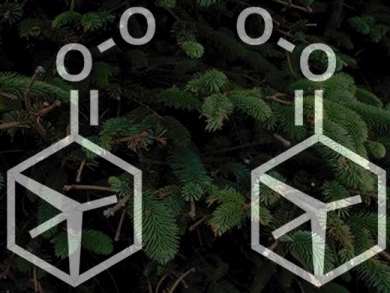Reactions of Terpenes With Ozone
Conifers emit volatile hydrocarbons, primarily terpenes, which we experience as the characteristic smell of the woods. In a complicated series of reactions involving ozone and sulfur dioxide, these compounds may be involved in the formation of aerosols that counteract the greenhouse effect. German scientists have now been able to follow the reaction of a terpene with ozone in the laboratory by using infrared (IR) spectroscopy. As they report in the journal Angewandte Chemie, they were able to identify critical intermediates of this process, namely the Criegee intermediates. They were also able to verify that these intermediates react very efficiently with sulfur dioxide.
Terpenes have a strong influence on the chemical processes that occur in the earth’s atmosphere, even though they are only present in trace amounts. Particularly in summer, these compounds are involved in the ozone chemistry of the troposphere. It has been shown that their oxidation plays a large role in the formation of secondary organic aerosols (SOAs), which influence our climate. These processes have not yet been completely explained and represent a large source of uncertainty in climate-prediction models. Researchers working with Thomas Zeuch at the University of Göttingen and the Karlsruhe Institute of Technology (KIT) have now gained new insights into the reactions of terpenes with ozone.
SOAs are liquid or solid particles that contain sulfuric acid (H2SO4) and are formed from gaseous precursors such as sulfur dioxide (SO2) and terpenes. Atmospheric sulfuric acid and the sulfuric acid and sulfate aerosol particles that are formed from it also contribute to acid rain. “At the same time, they work against the greenhouse effect,” explains Zeuch, “because they both promote cloud formation and reflect the sun’s radiation back into space.”
Detection of Criegee Intermediates
How does sulfuric acid get into the troposphere? “In addition to a sequence of reactions that starts with the oxidation of sulfur dioxide by hydroxyl radicals, an alternative pathway of oxidation by Criegee intermediates (CIs) has been proposed,” says Zeuch. These compounds are carbonyl oxides with two free-radical centers that account for their unusual chemistry. They are formed by the reaction of ozone with the double bonds in organic compounds such as terpenes. Until now, only small CIs formed through photolysis have been directly detected. In their study, Zeuch and his co-workers have now examined the reactions of the terpene called β-pinene, which is often found in plants, with ozone. “By using IR spectroscopy, we were able to detect large, stabilized CIs formed during the ozonolysis of pinene for the first time,” reports Zeuch. “These large CIs reacted with sulfur dioxide to form sulfur trioxide with a yield of over 80 %. Time-resolved experiments revealed that this reaction is very fast.” This unequivocally proves that SO2 is efficiently oxidized to tropospheric sulfuric acid by reaction with stabilized Criegee intermediates from terpenes.
- Infrared Detection of Criegee Intermediates Formed during the Ozonolysis of β-Pinene and Their Reactivity towards Sulfur Dioxide,
Jennifer Ahrens, Philip T. M. Carlsson, Nils Hertl, Matthias Olzmann, Mark Pfeifle, J. Lennard Wolf, Thomas Zeuch,
Angew. Chem. Int. Ed. 2014.
DOI: 10.1002/anie.201307327




